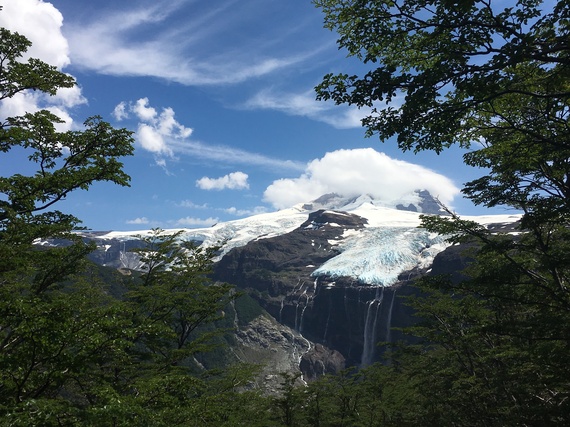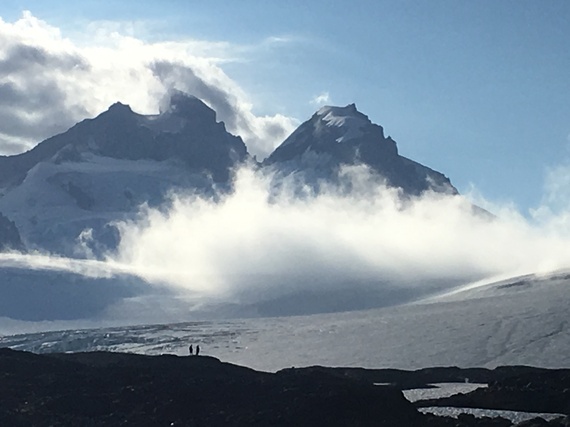Hiking up to the Refugio Otto Meiling through ancient forests of Antarctic beech, Patagonian cypress and bamboo, an occasional sonorous boom echoed through the trees. One of Mount Tronadour's ('The Thunderer') several glaciers calving thousands of tonnes of ice over its precipitous flanks hundreds of feet into the valley below.
The physical metamorphosis of huge chunks of solid ice pulverized into a billion tiny glistening pieces, dissolving into the river that carves a green swathe through the desert downstream. Meltwater rushed from beneath the glacier in cascades accelerating its slide from the mountain.The retreating ice sheet's gradual collapse, mirroring the fate of many all over the world, resonated in more ways than one.
It was a day of liminal space. Of crossing thresholds. The distinct, abrupt even, transitions of the natural landscape as we ascended to almost 2000m were highly visible. The end of the forest yielded to rough, broken igneous rock, which higher still became snow and the still vast mass of the glaciers surrounding the twin peaks.
The limits of habitats were clear. The Andean panorama that greeted us at the Refugio revealed the tree-line across multiple mountains lumbering away towards the horizon. The forests constrained by a harsh, cold, wind-blasted climate, with only ice-fractured scree and unforgiving rubble above.
Wildlife was similarly held back, sometimes mercifully. The persistent horse-flies that had harassed us throughout the forests took their leave as we entered the rocky transition zone. But we were not alone. Huge Condors, a member of the vulture family, spread their ten foot wide wings and effortlessly soared on the thermals and updrafts overhead. Only they were truly unlimited and our own ascent to these heights by comparison looked ungainly and laboured. They were at home in the high peaks. We were at the edge of our limits, and without the warm womb of the Refugio we'd have been well beyond them.
I'd tested my personal comfort zone too as our rugged path wound along a precarious ledge with scant margin for error. One slip, trip or miss-step on the treacherous gravelly surface would be enough to send the foolishly footed into the abyss.
Humanity stands on a similar edge. Our own sure-footed ascent has led us to the brink. We are experiencing our own liminality, an ambiguous disorientation, where the path that brought us to where we are now peters out and our next steps are no longer clear. Or if they are they are the wrong ones¬¬.
Yet liminality is all about reinvention, the moment when old traditions, customs and hierarchies become fluid. When previous assumptions of outcome unwravel, new uncertainties emerge and change is imperative. In this sense climate change is just one of the perfect 'progress traps' which we have set ourselves.
These occur when our pursuit of progress creates circumstances which fundamentally undermine our potential for future progress. Our desire for cheaply available, abundant energy in the form of fossil fuels for example now accelerates the accumulation of carbon dioxide in our atmosphere that is driving climate instability and threatening us all.
We should honour the past. The civilization we have built by burning millions of years of effectively fossilized sunshine is in many ways incredible. It has transformed us. Let us celebrate that. But we now find ourselves in the new context of a rapidly warming world which requires us to change. Or we succumb to the inherent madness of doing the same thing and expecting a different result.
Ours is a malleable time but riven by fear. As Antonio Gramsci put it 'the old is dying and the new cannot yet be born, and in this strange interregnum a whole host of morbid symptoms appear'. We are struggling to birth the new world we need.
Glacial retreat like that we witnessed on Tronadour is just one of our warnings, compelling us to act. The thirsty, blue-throated moulins that drain the melting ice on the glacier with a ghastly gargle are speaking to us. As are the thunderous ice falls. We'd do well to heed them.
The world is not limitless however much we might like to delude ourselves, and as the reach of life on the mountain demonstrates often those limits are tightly defined. Yet within them abundance also lies as it does in the rich fertility and diversity of the forests.
By respecting those limits we can unleash ourselves - ecstatically, by rising above our petty individualism and back to a joyous interconnection - returning to 'the one'. We stand on the threshold and consciously choose which way to step. One direction trips us into a disastrous descent. The other allows us to soar to new heights like the Condor.
Ed Gillespie is Co-Founder of www.wearefuterra.com, author of 'Only Planet - a flight-free adventure around the world' and off to the Antarctic...
Follow Ed Gillespie on Twitter: www.twitter.com/frucool and via #pole2soul
This blog is part of a series. Read other instalment's via the author's profile page.

